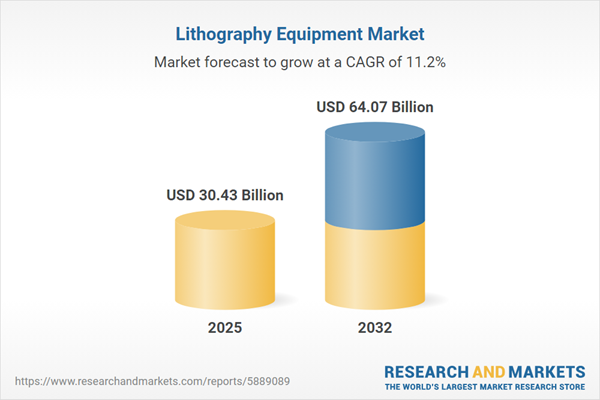Speak directly to the analyst to clarify any post sales queries you may have.
Senior executives navigating the lithography equipment market face accelerating innovation cycles, evolving manufacturing demands, and persistent uncertainty. Effective leadership in this sector rests on adopting advanced technologies, fostering adaptable operations, and building robust collaborations along the global semiconductor value chain.
Lithography Equipment Market Snapshot
The global lithography equipment market reached a valuation of USD 27.41 billion in 2024 and is projected to grow to USD 30.43 billion by 2025. Long-term forecasts indicate expansion to USD 64.07 billion by 2032, reflecting a compound annual growth rate (CAGR) of 11.19%.
This sustained growth is underpinned by progress in manufacturing process technologies, steady capital investments, and rapid integration of cutting-edge lithography systems. Market leaders are intensifying research initiatives, scaling infrastructure, and strengthening strategic partnerships. The evolving landscape requires sophisticated equipment to ensure manufacturing agility, operational excellence, and competitive differentiation throughout the semiconductor supply chain.Scope & Segmentation of the Lithography Equipment Market
This analysis equips leadership teams with clarity for executive planning and investment decisions in the lithography equipment market. Segmentation supports targeted strategies across multiple operational and technological domains:
- Wavelength: ArF Dry, ArF Immersion, EUV, I-Line, and KrF technologies deliver manufacturers flexibility for addressing complex device designs and specialized process requirements.
- Technology: Scanner and stepper systems enable distinct throughput levels and underpin the transition to finer semiconductor geometries and increased chip density.
- Wafer Size: Options spanning 100mm to 300mm support both legacy manufacturing lines and high-volume, advanced node production, helping organizations align capacity with market shifts.
- End-User Industry: Foundry, logic, and memory segments shape procurement approaches and foster close supplier collaborations to optimize supply chain efficiency.
- Application: Integrated circuits, MEMS, and compound semiconductors leverage new system integration techniques, driving device scaling and introducing transformative business models.
- Region: Coverage includes the Americas, Europe, Middle East & Africa, and Asia-Pacific, each with unique technology paths and policy environments influencing investment strategies.
- Covered Companies: Segment features ASML Holding N.V., Nikon Corporation, Canon Inc., Shanghai Micro Electronics Equipment Co. Ltd., Veeco Instruments Inc., NuFlare Technology Inc., SUSS MicroTec SE, EV Group GmbH, JEOL Ltd., and NAURA Technology Group Co. Ltd., serving as benchmarks for executive reference.
- Sub-Regions: In-depth insights on the United States, Germany, China, Japan, South Korea, India, United Kingdom, Canada, and Brazil assist in regulatory planning and risk mitigation across operational contexts.
Lithography Equipment Market: Key Takeaways for Senior Executives
- Upgrade strategies should align with industry protocols and harmonized supply agreements to facilitate seamless integration of advanced process capabilities.
- Joint research between equipment suppliers and chip manufacturers is strengthening system reliability in both light source and photomask performance, improving production consistency across global sites.
- Emerging manufacturing techniques, including multi-beam and nanoimprint lithography, are reshaping productivity metrics and reproducibility standards within the sector.
- Growing design intricacies are driving demand for adaptable lithography platforms capable of supporting evolving wafer sizes and complex layouts for next-generation devices.
- Rising competition is prompting expansion in research investments and compliance frameworks, ensuring enhanced supply chain security and nimble responses to shifting regulatory environments.
Tariff Impact
The anticipated introduction of U.S. tariffs on lithography components in 2025 is prompting manufacturers to reexamine sourcing structures and adjust supplier engagements. This regulatory evolution is increasing the importance of near-shoring and diversification strategies across manufacturing locations. Suppliers are expected to offer greater transparency and adaptive supply models, which bolster supply chain stability and sustain market competitiveness as policy conditions change.
Methodology & Data Sources
This report consolidates research from industry publications, regulatory submissions, and patent archives. Findings have been validated through executive interviews and scenario-based assessments, ensuring actionable relevance for semiconductor procurement leaders and strategy teams within the photolithography equipment space.
Why This Report Matters
- Provides actionable insights for confident resource allocation and strategic planning in the lithography equipment sector.
- Prepares leadership to respond proactively to sector disruptions, including supply fluctuations, tariff regulations, and evolving regional policies.
- Identifies high-potential market segments and highlights expected regulatory pathways, supporting executive prioritization and competitive positioning for sustained growth.
Conclusion
This analysis equips executives with the intelligence needed to guide their organizations through industry transformation and maintain strong performance as the lithography equipment market evolves.
Additional Product Information:
- Purchase of this report includes 1 year online access with quarterly updates.
- This report can be updated on request. Please contact our Customer Experience team using the Ask a Question widget on our website.
Table of Contents
3. Executive Summary
4. Market Overview
7. Cumulative Impact of Artificial Intelligence 2025
Companies Mentioned
The companies profiled in this Lithography Equipment market report include:- ASML Holding N.V.
- Nikon Corporation
- Canon Inc.
- Shanghai Micro Electronics Equipment Co., Ltd.
- Veeco Instruments Inc.
- NuFlare Technology, Inc.
- SUSS MicroTec SE
- EV Group GmbH
- JEOL Ltd.
- NAURA Technology Group Co., Ltd.
Table Information
| Report Attribute | Details |
|---|---|
| No. of Pages | 180 |
| Published | November 2025 |
| Forecast Period | 2025 - 2032 |
| Estimated Market Value ( USD | $ 30.43 Billion |
| Forecasted Market Value ( USD | $ 64.07 Billion |
| Compound Annual Growth Rate | 11.1% |
| Regions Covered | Global |
| No. of Companies Mentioned | 11 |







